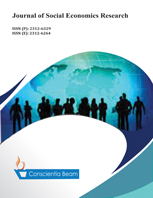Interfaces Between Road Infrastructure and Poverty in Africa: The Case of Malawi, 1994-2013
DOI:
https://doi.org/10.18488/journal.35.2017.41.9.21Abstract
Critical assessment on the correlation between public investment on road infrastructure and poverty was carried out, and therefore this research paper provides an in depth analyses of the linkage between road infrastructure and poverty, as well as, other relevant macro-economic variables used in the Malawi Growth and Development Strategy (MGDS) as target indicators. Using primary and secondary data from 1994-2013, dynamic time series models were applied in elaborating the various factors with thrust on road infrastructure that may influence poverty in Malawi. Noting poverty reduction as priority of Malawi Government’s development agenda since the early 1990s, MGDS provides the country’s socioeconomic growth and development platforms. According to the latest 2010 Integrated Household Survey (IHS3), the majority of Malawians (50.7 percent) are languishing in abysmal poverty; this level is remotely far from the MDGS target of 27 percent by end 2015. The country has a high inequality index (Gini 0.38) reflecting profound inequalities in access to assets, services and opportunities across the population. The distribution of the benefits of economic growth is also important for the alleviation of poverty. However, the distribution of income and wealth are highly skewed, with a majority of the population living in a state of absolute poverty. Based on NSO surveys (1998-2010), the poorest 20 percent of the population control only around 10 percent of national consumption implying inequality is not decreasing at all for long time. Hosts of factors explaining why poverty level continues to be rampant are: share of agricultural as a percent of GDP (proxy to agricultural production) and export as percent of GDP (proxy to exports). However, this paper findings show that there is significant (p=0.000<0.05) relationship between road network and poverty levels. Estimates from Granger Causality analysis indicate that for one percent increase in road network, a reduction of 7.2 percent in poverty level is perhaps achievable. Average inflation rate over the last 20 years stands at 22.41 percent, and this has an immense impact on poverty level since it dramatically reduces the purchasing power of the majority of the population. For a one percent increase in the inflation rate, there is a consequence of about 3.7 percent increase in the average poverty level. Average Gross Domestic Product (GDP) growth rate is 4.7 percent annually with a minimum of -4.9 percent and a maximum of 10.2 percent in the last 20 years. Poverty level appears to significantly respond to (GDP). There is a 4.27 percent reduction in poverty level if a one percent GDP increment takes place as shown in the dynamic time series analysis. In fact, the declining of agricultural production for export and the growing gap in balance of payment (average Malawi Kwacha -498.92 billion or approximately US$-1.1 billion) would immensely influence GDP negatively and therefore poverty becomes abysmal as GDP growth plummets. In a nutshell, the findings confirm that in the long run economic growth is the key to alleviation of extreme poverty since it creates the resources to raise incomes. Given the importance of agriculture in contributing towards GDP in Malawi, the positive impact that this sector has on poverty is evident. For agriculture to meaningfully impact economic growth, road infrastructure plays a great role. Other pro-poor variables such as development roads and other investment on infrastructure are vital for economic growth and hence poverty alleviation.

